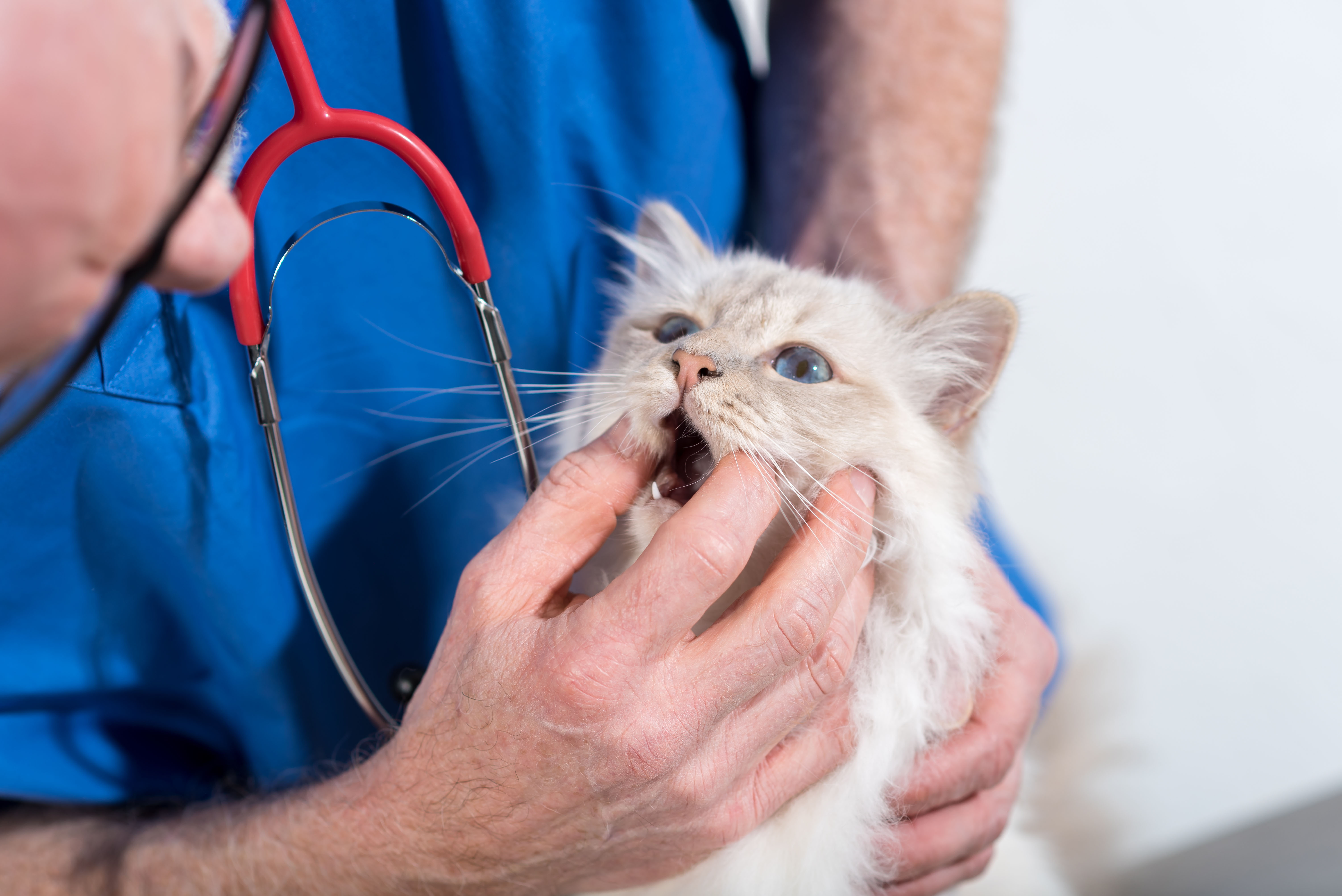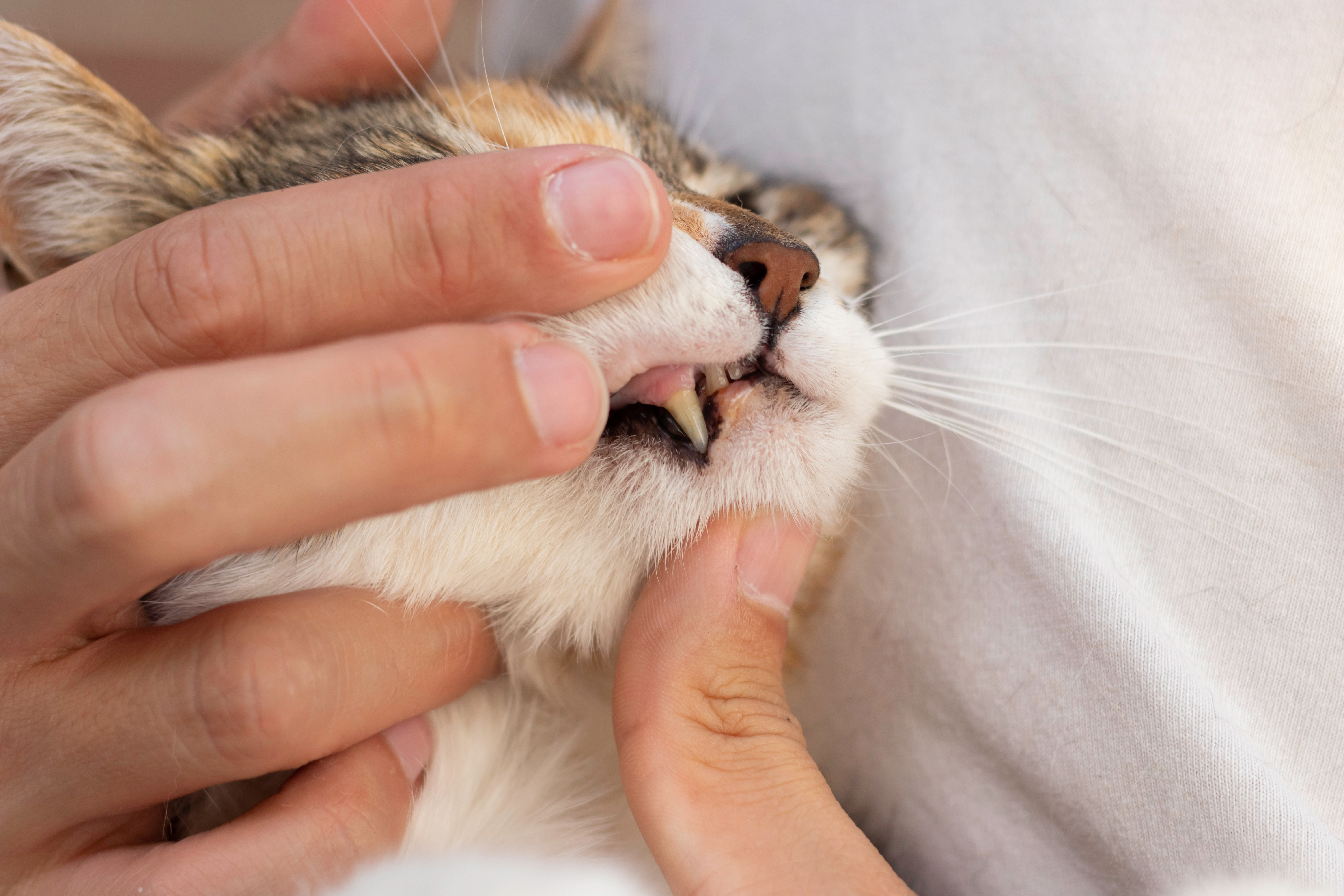Key Takeaways
- Dental care plays a vital role in overall cat health
- Brush a cat’s teeth daily and give them dental chews
- Go through annual professional dental cleanings
- Prevention of dental disease is better than treatment
- Consider a pet insurance wellness plan to cover routine dental costs

Dental problems can lead to systemic health issues that are painful and difficult to treat. Cavities, bad breath, and tooth loss hurt a surprisingly high percentage of cats. With dental problems, prevention is often easier and cheaper than treatment – especially since periodontal disease can’t be reversed.
A cat with good dental hygiene enjoys better overall health. Let’s go over cat dental health care, its importance, and common feline dental issues.

Understanding Feline Dental Health
While wild cats clean their teeth by chewing on bones and grass, domestic cats don’t usually have anything similar to gnaw on. This makes them prone to dental problems. When dental conditions worsen, they can lead to health problems throughout a cat’s body, such as heart disease.
It can be difficult to tell when cats have tooth pain or issues since they can only meow at us. Here are common dental health conditions in cats and their symptoms.
Gingivitis: Causes inflamed gums. Plaque buildup on teeth can lead to gingivitis. Untreated inflammation of the gums will likely lead to periodontal disease, which is much harder and more painful for cats to handle.
Periodontal disease: Periodontitis is an irreversible dental condition. It can result in tooth loss and other painful health issues for your cat.
Tooth resorption: Resorption refers to a dental injury or irritation, resulting in the partial loss of a tooth. Cat tooth resorption is also referred to as oral resorptive lesions and cervical neck lesions.
Halitosis: Persistent bad breath. May signify rotting teeth, which likely need to be removed. Proper and consistent brushing of teeth can reduce the chances of cat halitosis.
Preventive Dental Care Practices for Cats
Regular teeth brushing techniques and tools
Ideally, cats should have their teeth brushed every day. A consistent routine makes it easier to get your cat to cooperate with tooth brushing, though more training may be necessary.
When brushing a cat’s teeth, brush along the gum line. Be gentle and quick, there is no need to scrub every tooth. Use cat toothpaste! Human toothpaste can be dangerous to cats.
As you brush your cat’s teeth, watch out for certain dental warning signs. Understandably, cats may not enjoy your poking and prodding, so be patient and provide comforting praise as you gently perform a dental exam at home. Here are some signs your cat might have a dental issue that requires timely veterinarian attention:
- Swollen and red gums
- Yellow plaque along the gum line
- Hardened tartar
- Cracked or loose teeth
- Persistent bad breath
- Spots or redness
Dental-friendly diet options and treats
Diet plays an important role in the dental health of cats. In general, dry cat food is considered better for a cat’s oral hygiene, but other dietary choices are necessary to make a meaningful impact on your cat’s dental health.
Dental chews, toys, and treats are good methods for helping cats improve their oral hygiene. Try giving your cat a feline teeth cleaning toy as an addition to their typical dental routine.
Dental chews are formulated specifically so that cats will chew the treat in a way that removes plaque. These chews should primarily use healthy ingredients for cats that aren’t too sweet, salty, or fatty. Consistent use of dental chews can reduce dental disease in cats.
Remember, even if you give your cat plenty of dental toys and chews, they should still maintain a standard dental routine. Chews and toys cannot replace brushing.
Observe your cat eating
Cats might exhibit pain and discomfort when eating food. This is a sign that there is some issue that needs to be seen by a vet. This could be an appetite issue, an underlying health condition, or a dental problem. Veterinarians can perform blood work, X-rays, and dental exams to see what is wrong with your cat.
Professional Dental Care for Cats
Veterinary dental exams and cleanings
At a vet visit, the veterinarian will perform a thorough dental exam on your cat, which typically lasts an hour and involves:
-
- Looking at your cat’s teeth
-
- Going through pre-anesthesia screening
-
- Giving your cat mild anesthesia
-
- Cleaning your cat’s teeth using ultrasonic and manual scalers
-
- Polishing the teeth using dental products
-
- Planning follow-up appointments
Some cat owners feel hesitant about their cats going under anesthesia to receive teeth cleaning. Speak with your vet if you have any concerns. In general, anesthesia allows for more complete dental cleaning for cats.
Dental X-rays and diagnostics for detecting hidden issues
X-rays and medical imaging are great for detecting dental issues that you or vets can’t otherwise see. A dental X-ray may uncover:
- Extra roots
- Abscess
- Unrerupted or impacted teeth
- Bone cysts
Even without warning signs, a cat should ideally have their mouth X-rayed at least once every year. This helps with the early detection of any dental issues. Early detection means easier treatment and better prognosis, so it’s often worth performing annual X-ray check-ups of a cat’s mouth.
Note that the radiation used during dental X-rays is very minimal and safe. There have been no reports of harmful radiation effects on cats from dental X-rays.
Treatment options for dental problems
Here are the most common dental treatment options for cats and their estimated costs.
Dental cleaning: $100 to $400 for a deep dental cleaning session. Effectively removes plaque and tartar buildup, ensuring better oral hygiene for your cat. Scaling and polishing teeth during a dental cleaning process will remove plaque and tartar buildup, reducing the negative effects of feline periodontitis.
Root canal: $1,500 to $3,000. Root canal therapy is less invasive than the complete extraction of teeth but can be significantly more expensive.
Extractions: $50 to $300+. If a tooth has decayed or is causing too much pain and problems, it might need to be extracted.
Antibiotics and steroid therapy: Mild cases of oral inflammation might be treated by antibiotics, whereas more severe dental issues might be dealt with by corticosteroids.
Sourcing Pet Insurance for Dental Care
Pet insurance is a form of financial protection that provides reimbursements for eligible veterinary expenses. Obtaining a pet insurance policy can make it easier for you to provide your kitty with dental care.
Benefits of pet insurance in managing dental expenses for cats
Financial coverage: Dental issues can be expensive to treat for cats, requiring hundreds if not thousands of dollars. A good pet insurance policy can cut down your vet expenses, lowering the financial burden on your shoulders while ensuring your cat gets the dental attention they need.
Prepared for emergencies: If your cat gets into an accident that ends up with dental injuries, pet insurance might be able to cover a significant portion of the emergency treatment expenses. Since emergency vet bills for fractured teeth and other issues can be very expensive, pet insurance makes it easier for pet owners to afford urgent medical care for their cats.
Peace of mind: Pet owners with pet insurance for dental care can rest assured their expenses will be covered by insurance. This lets them better focus on getting their cats the necessary medical attention without stressing over the financial impact.
Factors to consider when choosing a pet insurance plan with dental coverage
Premium: This is how much you need to pay for active pet insurance coverage for your cat every month. A higher premium usually means more comprehensive coverage and/or a lower deductible. Choose a premium that works with your budget. Comprehensive insurance premiums for cats average around $32.
Deductible: Before insurance kicks in, you need to first meet the pet insurance deductible. Cat insurance deductibles range between $0 to $1000, with most cat owners choosing a plan with a $250 deductible.
Coverage type: Accident pet insurance won’t be able to cover illnesses or routine care, but it is substantially cheaper. Think about what type of insurance would best suit your cat’s needs and your financial situation.
Insurer reliability: It’s important to choose a pet insurance provider with good financial stability and customer service. Read reviews and testimonials to find out what customers think of each pet insurance carrier.
Add-ons: A wellness plan (preventive care) add-on will cover routine dental cleanings. Generally, wellness plans have faster reimbursement times. If you want a valuable deal when obtaining pet insurance for cat dental care, a wellness plan is highly recommended.
Types of pet insurance policies available for dental care
Accident-only pet insurance: Covers expenses for accidents, such as broken bones, toxic ingestion, and lacerations. Dental accidents are typically covered. However, accident-only pet insurance policies do not cover routine dental costs.
Accident and illness coverage: This comprehensive coverage will provide financial protection for both accidents and illnesses. Common eligible illnesses include cancer, diabetes, and thyroid issues in cats. Most comprehensive pet insurance plans cover dental accidents and conditions. However, routine dental care might require a preventive care add-on.
Wellness plan: Covers preventive and routine care, including routine dental cleanings. Typically sold as an insurance add-on to pet insurance policies. Wellness plans are often an excellent choice for cat owners since dental care is vital for good feline health.
Top pet insurance providers
It’s good to know where to begin when sourcing pet insurance. Here are some of the top pet insurance providers with excellent coverage options for dental care.
- Pumpkin: Multi-pet discounts on excellent coverage.
- ASPCA: Great dental care wellness plan options.
- Lemonade: Affordable plans for cat insurance start at $10 a month.
- Embrace: You can get up to 90% back on vet bills.
Importance of Budgeting for Dental Expenses
Cost considerations for routine dental care and treatment of dental issues in cats
A routine dental cleaning for cats costs anything from $100 to $400 depending on the chosen veterinarian and your cat’s medical condition. Cat owners can plan to pay for a deep dental cleaning once a year if their cat has good dental hygiene.
If their cat has poor dental health or risk factors that worsen their overall health (e.g. they are immunocompromised), more veterinary care might be necessary. Consult with your vet to determine an individualized dental care plan that suits your cat.
Planning for dental expenses
Dental expenses are a natural part of overall cat ownership costs. If accidents or infections arise, treatment for dental issues can be higher upfront. Because of this, it is advisable to have pet insurance as well as an emergency pet fund.
An emergency pet fund of a few hundred dollars can ensure that if your cat falls injured or ill, such as fracturing a tooth, you will be able to provide them with emergency medical attention. Try to avoid dipping into your emergency pet savings unless it is truly an emergency for you or your pet.
How pet insurance can help cat owners
The price of owning and caring for a cat can vary greatly depending on a variety of factors — your cat’s breed, medical health, indoor v.s. outdoor lifestyle, and diet. It’s not always easy paying for vet bills, especially urgent ones that arise from unexpected accidents.
Pet insurance can offset dental expenses and provide financial peace of mind. When you know insurance is there to cover your eligible expenses in case of a feline medical crisis, it can be much less stressful to take care of your cat.

Summary
Dental care helps a cat maintain good dental hygiene and health. This enhances their overall quality of life and well-being. Cats should receive:
- Daily teeth brushing
- Dental chews and toys
- Dental cleanings at least once a year
- Cat-friendly toothpaste and diets
Cat owners should prioritize their cats’ dental health by establishing a proper dental hygiene routine. Seek veterinary care as needed so any tooth and gum problems can be promptly detected.




























